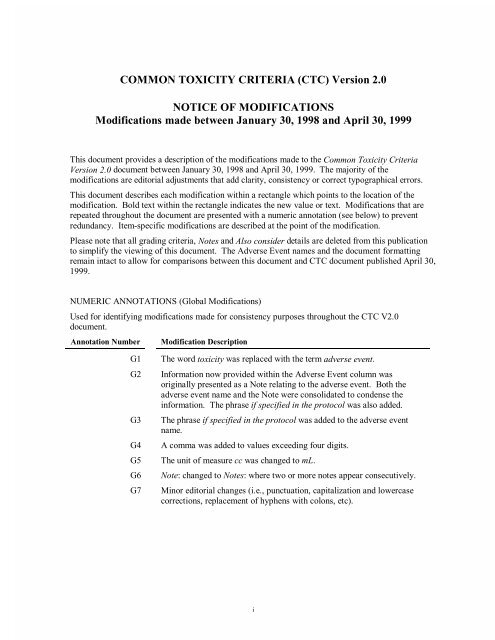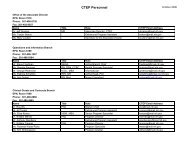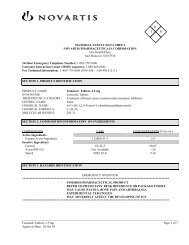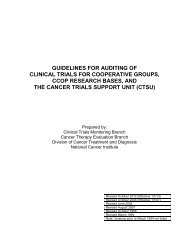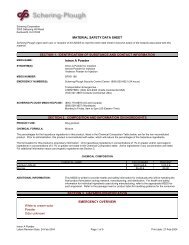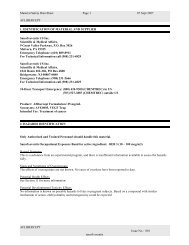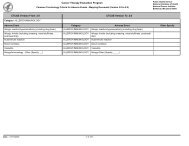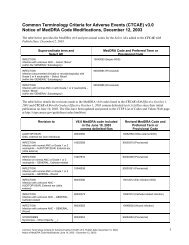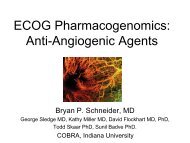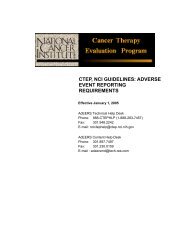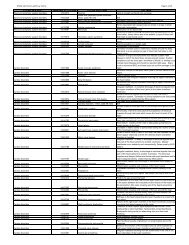Common Toxicity Criteria - Cancer Therapy Evaluation Program ...
Common Toxicity Criteria - Cancer Therapy Evaluation Program ...
Common Toxicity Criteria - Cancer Therapy Evaluation Program ...
You also want an ePaper? Increase the reach of your titles
YUMPU automatically turns print PDFs into web optimized ePapers that Google loves.
COMMON TOXICITY CRITERIA (CTC) Version 2.0<br />
NOTICE OF MODIFICATIONS<br />
Modifications made between January 30, 1998 and April 30, 1999<br />
This document provides a description of the modifications made to the <strong>Common</strong> <strong>Toxicity</strong> <strong>Criteria</strong><br />
Version 2.0 document between January 30, 1998 and April 30, 1999. The majority of the<br />
modifications are editorial adjustments that add clarity, consistency or correct typographical errors.<br />
This document describes each modification within a rectangle which points to the location of the<br />
modification. Bold text within the rectangle indicates the new value or text. Modifications that are<br />
repeated throughout the document are presented with a numeric annotation (see below) to prevent<br />
redundancy. Item-specific modifications are described at the point of the modification.<br />
Please note that all grading criteria, Notes and Also consider details are deleted from this publication<br />
to simplify the viewing of this document. The Adverse Event names and the document formatting<br />
remain intact to allow for comparisons between this document and CTC document published April 30,<br />
1999.<br />
NUMERIC ANNOTATIONS (Global Modifications)<br />
Used for identifying modifications made for consistency purposes throughout the CTC V2.0<br />
document.<br />
Annotation Number Modification Description<br />
G1 The word toxicity was replaced with the term adverse event.<br />
G2 Information now provided within the Adverse Event column was<br />
originally presented as a Note relating to the adverse event. Both the<br />
adverse event name and the Note were consolidated to condense the<br />
information. The phrase if specified in the protocol was also added.<br />
G3 The phrase if specified in the protocol was added to the adverse event<br />
name.<br />
G4 A comma was added to values exceeding four digits.<br />
G5 The unit of measure cc was changed to mL.<br />
G6 Note: changed to Notes: where two or more notes appear consecutively.<br />
G7 Minor editorial changes (i.e., punctuation, capitalization and lowercase<br />
corrections, replacement of hyphens with colons, etc).<br />
i
CTC NOTICE OF MODIFICATIONS<br />
COMMON TOXICITY CRITERIA (CTC)<br />
Adverse Event 0 1 2 3 4<br />
Allergic reaction/<br />
hypersensitivity<br />
(including drug fever)<br />
Note: Isolated urticaria…<br />
Allergic rhinitis<br />
(including sneezing, nasal<br />
stuffiness, postnasal drip)<br />
Autoimmune reaction<br />
Also consider Hypothyroidism...<br />
Serum sickness<br />
Urticaria is graded...<br />
Vasculitis<br />
Allergy/Immunology - Other<br />
(Specify, __________)<br />
Conductive hearing loss is graded...<br />
Earache is graded...<br />
External auditory canal<br />
G1<br />
Note: Changes associated...<br />
The organization, document title and<br />
date were added to the footer.<br />
Grade<br />
ALLERGY/IMMUNOLOGY<br />
AUDITORY/HEARING<br />
Version 2.0<br />
Publish Date: April 30, 1999<br />
<strong>Cancer</strong> <strong>Therapy</strong> <strong>Evaluation</strong> <strong>Program</strong><br />
<strong>Common</strong> <strong>Toxicity</strong> <strong>Criteria</strong>, Version 2.0<br />
DCTD, NCI, NIH, DHHS March 1998<br />
1<br />
Revised March 23, 1998<br />
G1
CTC NOTICE OF MODIFICATIONS<br />
Adverse Event 0 1 2 3 4<br />
Inner ear/hearing<br />
Middle ear/hearing<br />
Auditory/Hearing - Other<br />
(Specify, __________)<br />
Bone marrow cellularity<br />
Normal ranges:<br />
children (≤ 18 years)<br />
younger adults (19-59)<br />
older adults (≥ 60 years)<br />
Note: Grade Bone...<br />
CD4 count<br />
Haptoglobin<br />
Hemoglobin (Hgb)<br />
For leukemia studies or bone<br />
marrow infiltrative/<br />
myelophthisic processes, if<br />
specified in the protocol.<br />
Hemolysis (e.g., immune<br />
hemolytic anemia, drugrelated<br />
hemolysis, other)<br />
Also consider Haptoglobin…<br />
Grade<br />
BLOOD/BONE MARROW<br />
The Grade 1 value for Bone marrow cellularity was changed to<br />
mildly hypocellular or ≤ 25% reduction (“≤” was added).<br />
The row listing normal ranges for children was<br />
shaded and the text changed to italic to indicate<br />
pediatric information.<br />
G2<br />
The abbreviation Hgb was written in<br />
full as Hemoglobin.<br />
Version 2.0<br />
Publish Date: April 30, 1999<br />
The value for Grade 3 Hemoglobin was<br />
changed to 65 - < 80 g/L (“
CTC NOTICE OF MODIFICATIONS<br />
Adverse Event 0 1 2 3 4<br />
Leukocytes (total WBC)<br />
For BMT studies, if<br />
specified in the protocol.<br />
For pediatric BMT studies<br />
(using age, race and sex<br />
normal values), if specified<br />
in the protocol.<br />
Lymphopenia<br />
For pediatric BMT studies<br />
(using age, race and sex<br />
normal values), if specified<br />
in the protocol.<br />
Neutrophils/granulocytes<br />
(ANC/AGC)<br />
For BMT studies, if<br />
specified in the protocol.<br />
For leukemia studies or bone<br />
marrow infiltrative/<br />
myelophthisic process, if<br />
specified in the protocol.<br />
Platelets<br />
For BMT studies, if<br />
specified in the protocol.<br />
For leukemia studies or bone<br />
marrow infiltrative/<br />
myelophthisic process, if<br />
specified in the protocol.<br />
Transfusion: Platelets<br />
For BMT studies, if<br />
specified in the protocol.<br />
Also consider Platelets.<br />
G2<br />
G2<br />
G2<br />
G3<br />
Grade<br />
The Grade 1 Platelets value was changed<br />
to < LLN - 75.0 x 10 9 /L (“
CTC NOTICE OF MODIFICATIONS<br />
Adverse Event 0 1 2 3 4<br />
Transfusion: pRBCs<br />
For BMT studies, if<br />
specified in the protocol.<br />
Grade<br />
For pediatric BMT studies, if<br />
specified in the protocol<br />
The values for Transfusion: pRBCs for Pediatric BMT<br />
studies were separated from Transfusion: pRBCs BMT<br />
values (above) creating a new Adverse Event row.<br />
Also consider Hemoglobin.<br />
Blood/Bone Marrow - Other<br />
(Specify, __________)<br />
Conduction abnormality/<br />
Atrioventricular heart block<br />
Nodal/junctional<br />
arrhythmia/dysrhythmia<br />
Palpitations<br />
Note: Grade palpitations...<br />
Prolonged QTc interval<br />
(QTc > 0.48 seconds)<br />
Sinus bradycardia<br />
Sinus tachycardia<br />
Supraventricular arrhythmias<br />
(SVT/atrial fibrillation/<br />
flutter)<br />
Syncope (fainting) is...<br />
Vasovagal episode<br />
G3<br />
CARDIOVASCULAR (ARRHYTHMIA)<br />
Version 2.0<br />
Publish Date: April 30, 1999<br />
<strong>Cancer</strong> <strong>Therapy</strong> <strong>Evaluation</strong> <strong>Program</strong><br />
<strong>Common</strong> <strong>Toxicity</strong> <strong>Criteria</strong>, Version 2.0<br />
DCTD, NCI, NIH, DHHS March 1998<br />
4<br />
Revised March 23, 1998<br />
G5<br />
The Grade 2 value for<br />
Transfusion: pRBCs for<br />
Pediatric BMT studies was<br />
modified by adding a hyphen to<br />
designate a range of values.
CTC NOTICE OF MODIFICATIONS<br />
Adverse Event 0 1 2 3 4<br />
Ventricular arrhythmia<br />
(PVCs/bigeminy/trigeminy/<br />
ventricular tachycardia)<br />
Cardiovascular/<br />
Arrhythmia - Other<br />
(Specify, ___________)<br />
Acute vascular leak<br />
syndrome<br />
Cardiac-ischemia/infarction<br />
Cardiac left ventricular<br />
function<br />
CNS cerebrovascular ischemia is...<br />
Cardiac troponin I (cTnI)<br />
Cardiac troponin T (cTnT)<br />
Edema<br />
Hypertension<br />
*Note: For pediatric patient...<br />
Grade<br />
CARDIOVASCULAR (GENERAL)<br />
Version 2.0<br />
Publish Date: April 30, 1999<br />
<strong>Cancer</strong> <strong>Therapy</strong> <strong>Evaluation</strong> <strong>Program</strong><br />
<strong>Common</strong> <strong>Toxicity</strong> <strong>Criteria</strong>, Version 2.0<br />
DCTD, NCI, NIH, DHHS March 1998<br />
5<br />
Revised March 23, 1998
CTC NOTICE OF MODIFICATIONS<br />
Adverse Event 0 1 2 3 4<br />
Hypotension<br />
Also consider Syncope (fainting).<br />
Notes: Angina or MI is graded...<br />
Myocarditis<br />
For pediatric patients…<br />
Operative injury of<br />
vein/artery<br />
Pericardial effusion/<br />
pericarditis<br />
Peripheral arterial ischemia<br />
Phlebitis (superficial)<br />
Notes: Injection...<br />
Thrombosis/embolism...<br />
Syncope (fainting) is...<br />
Thrombosis/embolism<br />
Vein/artery operative injury is...<br />
Visceral arterial ischemia<br />
(non-myocardial)<br />
Cardiovascular/<br />
General - Other<br />
(Specify, ______________)<br />
G6<br />
Grade<br />
Version 2.0<br />
Publish Date: April 30, 1999<br />
The Grade 3 criterion for Pericardial effusion/pericarditis<br />
was revised to with physiologic consequences<br />
(“resulting from symptoms” deleted).<br />
<strong>Cancer</strong> <strong>Therapy</strong> <strong>Evaluation</strong> <strong>Program</strong><br />
<strong>Common</strong> <strong>Toxicity</strong> <strong>Criteria</strong>, Version 2.0<br />
DCTD, NCI, NIH, DHHS March 1998<br />
6<br />
Revised March 23, 1998
CTC NOTICE OF MODIFICATIONS<br />
Adverse Event 0 1 2 3 4<br />
Note: See the HEMORRHAGE...<br />
DIC<br />
(disseminated intravascular<br />
coagulation)<br />
Also consider Platelets.<br />
Note: Must have…<br />
Fibrinogen<br />
For leukemia studies or bone<br />
marrow infiltrative/<br />
myelophthisic process, if<br />
specified in the protocol.<br />
Partial thromboplastin time<br />
(PTT)<br />
Phlebitis is graded...<br />
Prothrombin time (PT)<br />
Thrombosis/embolism is graded...<br />
Thrombotic<br />
microangiopathy (e.g.,<br />
thrombotic<br />
thrombocytopenic<br />
purpura/TTP or hemolytic<br />
uremic syndrome/HUS)<br />
For BMT studies, if<br />
specified in the protocol.<br />
Also consider Hemoglobin...<br />
Note: Must have...<br />
Coagulation - Other<br />
(Specify, __________)<br />
Fatigue<br />
(lethargy, malaise, asthenia)<br />
Note: See Appendix III...<br />
The word grade was replaced<br />
with the word consider.<br />
G2<br />
The spelling for the word<br />
Phlebitis was corrected.<br />
G3<br />
Grade<br />
COAGULATION<br />
CONSTITUTIONAL SYMPTOMS<br />
Version 2.0<br />
Publish Date: April 30, 1999<br />
The Grade 4 value for Fibrinogen for<br />
leukemia studies or bone marrow<br />
infiltrative/ myelophthisic process was<br />
changed to
CTC NOTICE OF MODIFICATIONS<br />
Adverse Event 0 1 2 3 4<br />
Fever (in the absence of<br />
neutropenia, where<br />
neutropenia is defined as<br />
AGC < 1.0 x 10 9 /L)<br />
Also consider Allergic...<br />
Note: The temperature...<br />
Hot flashes/flushes...<br />
Rigors, chills<br />
Sweating<br />
(diaphoresis)<br />
Weight gain<br />
Also consider Ascites…<br />
Weight gain associated with<br />
Veno-Occlusive Disease<br />
(VOD) for BMT studies, if<br />
specified in the protocol.<br />
Grade<br />
Also consider Ascites…<br />
Weight loss<br />
The Also consider Ascites, Edema, Pleural effusion<br />
(non-malignant) was added to Weight gain associated<br />
Also consider Vomiting...<br />
with Veno-Occlusive Disease for BMT studies.<br />
Constitutional Symptoms -<br />
Other<br />
(Specify, __________)<br />
Alopecia<br />
Bruising<br />
(in absence of grade 3 or 4<br />
thrombocytopenia)<br />
Note: Bruising resulting...<br />
Dry skin<br />
Erythema multiforme (e.g.,<br />
Stevens-Johnson syndrome,<br />
toxic epidermal necrolysis)<br />
Flushing<br />
Hand-foot skin reaction<br />
Injection site reaction<br />
The Also consider for Weight gain was changed to<br />
include the term Pleural effusion (non-malignant).<br />
G2<br />
G7<br />
DERMATOLOGY/SKIN<br />
The adverse event Dermatitis, focal (associated with<br />
high-dose chemotherapy and bone marrow transplant)<br />
originally listed between Bruising and Dry skin was<br />
renamed Rash/dermatitis and moved to page 9.<br />
Version 2.0<br />
Publish Date: April 30, 1999<br />
The spelling for the word<br />
ascites was corrected.<br />
<strong>Cancer</strong> <strong>Therapy</strong> <strong>Evaluation</strong> <strong>Program</strong><br />
<strong>Common</strong> <strong>Toxicity</strong> <strong>Criteria</strong>, Version 2.0<br />
DCTD, NCI, NIH, DHHS March 1998<br />
8<br />
Revised March 23, 1998
CTC NOTICE OF MODIFICATIONS<br />
Adverse Event 0 1 2 3 4<br />
Nail changes<br />
Petechiae is graded…<br />
Photosensitivity<br />
Pigmentation changes (e.g.,<br />
vitiligo)<br />
Pruritus<br />
Purpura is graded...<br />
Radiation dermatitis<br />
Note: Pain associated...<br />
Radiation recall reaction<br />
(reaction following<br />
chemotherapy in the absence<br />
of additional radiation<br />
therapy that occurs in a<br />
previous radiation port)<br />
Rash/desquamation<br />
Also consider Allergic reaction/hypersensitivity.<br />
Note: Stevens-Johnson syndrome...<br />
Rash/dermatitis associated<br />
with high-dose<br />
chemotherapy or BMT<br />
studies.<br />
Rash/desquamation<br />
G2<br />
associated with graft versus<br />
host disease (GVHD) for<br />
BMT studies, if specified in<br />
the protocol.<br />
The event name for Rash/desquamation for BMT<br />
was revised to Rash/ desquamation associated<br />
with graft versus host disease (GVHD) for BMT<br />
studies, if specified in the protocol.<br />
Also consider Allergic reaction/hypersensitivity.<br />
Note: Stevens-Johnson syndrome...<br />
Grade<br />
The Note for Rash/desquamation was changed to Stevens-<br />
Johnson syndrome is graded separately as Erythema<br />
multiforme in the DERMATOLOGY/SKIN category.<br />
Dermatitis, focal was renamed Rash/dermatitis associated<br />
with high-dose chemotherapy or BMT studies and moved<br />
under Rash/desquamation (see page 8 for details).<br />
The spelling for the word<br />
pruritus was corrected.<br />
Version 2.0<br />
Publish Date: April 30, 1999<br />
<strong>Cancer</strong> <strong>Therapy</strong> <strong>Evaluation</strong> <strong>Program</strong><br />
<strong>Common</strong> <strong>Toxicity</strong> <strong>Criteria</strong>, Version 2.0<br />
DCTD, NCI, NIH, DHHS March 1998<br />
9<br />
Revised March 23, 1998<br />
G7
CTC NOTICE OF MODIFICATIONS<br />
Adverse Event 0 1 2 3 4<br />
Urticaria<br />
(hives, welts, wheals)<br />
Wound-infectious<br />
Wound-non-infectious<br />
Dermatology/Skin - Other<br />
(Specify, ________)<br />
Cushingoid appearance (e.g.,<br />
moon face, buffalo hump,<br />
centripetal obesity,<br />
cutaneous striae)<br />
Also consider Hyperglycemia...<br />
Feminization of male<br />
Gynecomastia<br />
Hot flashes/flushes<br />
Hypothyroidism<br />
Masculinization of female<br />
SIADH (syndrome of<br />
inappropriate antidiuretic<br />
hormone)<br />
Endocrine - Other<br />
(Specify, __________)<br />
Amylase is graded in the METABOLIC/LABORATORY category.<br />
Anorexia<br />
Ascites (non-malignant)<br />
Colitis<br />
Also consider Hemorrhage...<br />
Constipation<br />
Grade<br />
ENDOCRINE<br />
The exempli gratia (e.g.) for Cushingoid appearance was changed to e.g., moon face,<br />
buffalo hump, centripetal obesity, cutaneous striae (“with or without” was deleted).<br />
GASTROINTESTINAL<br />
Version 2.0<br />
Publish Date: April 30, 1999<br />
The spelling for the word<br />
fasciitis was corrected.<br />
<strong>Cancer</strong> <strong>Therapy</strong> <strong>Evaluation</strong> <strong>Program</strong><br />
<strong>Common</strong> <strong>Toxicity</strong> <strong>Criteria</strong>, Version 2.0<br />
DCTD, NCI, NIH, DHHS March 1998<br />
10<br />
Revised March 23, 1998
CTC NOTICE OF MODIFICATIONS<br />
Adverse Event 0 1 2 3 4<br />
Dehydration<br />
Also consider Diarrhea...<br />
Diarrhea<br />
Patients without colostomy:<br />
Patients with a colostomy:<br />
Diarrhea associated with<br />
graft versus host disease<br />
(GVHD) for BMT studies, if<br />
specified in the protocol.<br />
For Pediatric BMT studies,<br />
if specified in the protocol.<br />
Also consider Hemorrhage...<br />
Duodenal ulcer (requires<br />
radiographic or endoscopic<br />
documentation)<br />
Dyspepsia/heartburn<br />
Dysphagia, esophagitis,<br />
odynophagia (painful<br />
swallowing)<br />
Note: If the adverse event is...<br />
Dysphagia-esophageal<br />
related to radiation<br />
Also consider Pain<br />
Note: Fistula is...<br />
Dysphagia-pharyngeal<br />
related to radiation<br />
Also consider Pain due...<br />
Note: Fistula is graded...<br />
Fistula-esophageal<br />
Fistula-intestinal<br />
Grade<br />
The Also Consider for Dehydration was changed to Diarrhea,<br />
Vomiting, Stomatitis/pharyngitis (oral/ pharyngeal mucositis),<br />
Hypotension (“Hypotension” moved to the end of the sentence).<br />
The event Diarrhea for BMT studies was changed to<br />
Diarrhea associated with graft versus host disease<br />
(GVHD) for BMT studies, if specified in the protocol.<br />
G3<br />
G1<br />
The Also Consider for Diarrhea was changed by<br />
removing the row shading to indicate that it<br />
relates to all four (4) Diarrhea adverse events.<br />
Version 2.0<br />
Publish Date: April 30, 1999<br />
<strong>Cancer</strong> <strong>Therapy</strong> <strong>Evaluation</strong> <strong>Program</strong><br />
<strong>Common</strong> <strong>Toxicity</strong> <strong>Criteria</strong>, Version 2.0<br />
DCTD, NCI, NIH, DHHS March 1998<br />
11<br />
Revised March 23, 1998<br />
G7
CTC NOTICE OF MODIFICATIONS<br />
Adverse Event 0 1 2 3 4<br />
Fistula-pharyngeal<br />
Fistula-rectal/anal<br />
Flatulence<br />
Gastric ulcer<br />
(requires radiographic or<br />
endoscopic documentation)<br />
Also consider Hemorrhage/...<br />
Gastritis<br />
Also consider Hemorrhage...<br />
Hematemesis is graded...<br />
Hematochezia is graded...<br />
Ileus (or neuroconstipation)<br />
Mouth dryness<br />
Mucositis<br />
Notes: Mucositis not due to radiation...<br />
Radiation-related mucositis...<br />
Mucositis due to radiation<br />
Also consider Pain due to radiation.<br />
Notes: Grade radiation mucositis…<br />
Nausea<br />
Pancreatitis<br />
Dysphagia related to...<br />
Also consider Hypotension.<br />
Note: Amylase...<br />
Pharyngitis is graded...<br />
G6<br />
G6<br />
Grade<br />
The spelling for the word<br />
Vaginitis was corrected.<br />
The Note for Pancreatitis was revised to Amylase is<br />
graded in the METABOLIC/LABORATORY category<br />
(“Asymptomatic Amylase and” was deleted).<br />
Version 2.0<br />
Publish Date: April 30, 1999<br />
<strong>Cancer</strong> <strong>Therapy</strong> <strong>Evaluation</strong> <strong>Program</strong><br />
<strong>Common</strong> <strong>Toxicity</strong> <strong>Criteria</strong>, Version 2.0<br />
DCTD, NCI, NIH, DHHS March 1998<br />
12<br />
Revised March 23, 1998
CTC NOTICE OF MODIFICATIONS<br />
Adverse Event 0 1 2 3 4<br />
Proctitis<br />
Also consider Hemorrhage...<br />
Notes: Fistula is graded...<br />
Proctitis occurring...<br />
Salivary gland changes<br />
Sense of smell<br />
Stomatitis/pharyngitis<br />
(oral/pharyngeal mucositis)<br />
For BMT studies, if<br />
specified in the protocol.<br />
Note: Radiation-related mucositis...<br />
Taste disturbance<br />
(dysgeusia)<br />
Typhlitis<br />
(inflammation of the cecum)<br />
Also consider Hemorrhage/...<br />
Vomiting<br />
Also consider Dehydration.<br />
Weight gain is graded in…<br />
Weight loss is graded in...<br />
Gastrointestinal – Other<br />
(Specify, __________)<br />
G6<br />
G3<br />
Grade<br />
Version 2.0<br />
Publish Date: April 30, 1999<br />
The Also consider for Proctitis was changed to Hemorrhage/bleeding with<br />
grade 3 or 4 thrombocytopenia, Hemorrhage/bleeding without grade 3 or<br />
4 thrombocytopenia, Pain due to radiation (the word “and” was deleted).<br />
G7<br />
The spelling for the word<br />
prophylactic was corrected.<br />
The Grade 3 criteria for Typhlitis was revised<br />
to abdominal pain, diarrhea, fever, and<br />
radiographic or biopsy documentation.<br />
The term Febrile/neutropenia in the Also consider for Typhlitis<br />
was changed to Febrile neutropenia (“/” was deleted).<br />
<strong>Cancer</strong> <strong>Therapy</strong> <strong>Evaluation</strong> <strong>Program</strong><br />
<strong>Common</strong> <strong>Toxicity</strong> <strong>Criteria</strong>, Version 2.0<br />
DCTD, NCI, NIH, DHHS March 1998<br />
13<br />
Revised March 23, 1998<br />
G7<br />
G7
CTC NOTICE OF MODIFICATIONS<br />
Adverse Event 0 1 2 3 4<br />
Notes: Transfusion in this...<br />
For any bleeding with...<br />
If the site or type of Hemorrhage...<br />
If the platelet...<br />
Hemorrhage/bleeding with<br />
grade 3 or 4<br />
thrombocytopenia<br />
Also consider Platelets...<br />
Note: This adverse event must...<br />
Hemorrhage/bleeding<br />
without grade 3 or 4<br />
thrombocytopenia<br />
Also consider Platelets...<br />
Note: Bleeding in...<br />
CNS hemorrhage/bleeding<br />
Epistaxis<br />
Hematemesis<br />
Hematuria<br />
(in the absence of vaginal<br />
bleeding)<br />
Hemoptysis<br />
Hemorrhage/bleeding<br />
associated with surgery<br />
Note: Expected blood loss...<br />
Melena/GI bleeding<br />
G6<br />
G1<br />
G7<br />
G1<br />
G7<br />
G7<br />
Grade<br />
HEMORRHAGE<br />
Version 2.0<br />
Publish Date: April 30, 1999<br />
The Note beginning with “For any bleeding with…” was revised to …in<br />
addition to grading severity by grading the site or type of bleeding.<br />
The Also consider for Hemorrhage/bleeding with grade 3 or 4 thrombocytopenia<br />
was revised to Platelets, Hemoglobin, Transfusion-platelets, TransfusionpRBCs<br />
site or type of bleeding. If the site is not listed, grade as Hemorrhage-<br />
Other (Specify site, _______).<br />
The Note for Hemorrhage/bleeding with grade 3 or 4 thrombocytopenia was<br />
revised by deleting the sentence “Also grade the site or type of hemorrhage/<br />
bleeding. If the site is not listed, grade as Other in the HEMORRHAGE category”.<br />
The Also consider for Hemorrhage/bleeding without grade 3 or 4 thrombocytopenia<br />
was revised by adding Hemorrhage-Other (Specify site, _________).<br />
<strong>Cancer</strong> <strong>Therapy</strong> <strong>Evaluation</strong> <strong>Program</strong><br />
<strong>Common</strong> <strong>Toxicity</strong> <strong>Criteria</strong>, Version 2.0<br />
DCTD, NCI, NIH, DHHS March 1998<br />
14<br />
Revised March 23, 1998
CTC NOTICE OF MODIFICATIONS<br />
Adverse Event 0 1 2 3 4<br />
Petechiae/purpura<br />
(hemorrhage/bleeding into<br />
skin or mucosa)<br />
Rectal bleeding/<br />
hematochezia<br />
Vaginal bleeding<br />
Hemorrhage - Other<br />
(Specify site, ___________)<br />
Alkaline phosphatase<br />
Bilirubin<br />
Bilirubin associated with<br />
graft versus host disease<br />
(GVHD) for BMT studies, if<br />
specified in the protocol.<br />
GGT<br />
(γ - Glutamyl transpeptidase)<br />
Hepatic enlargement<br />
Note: Grade Hepatic...<br />
Hypoalbuminemia<br />
Liver dysfunction/ failure<br />
(clinical)<br />
Portal vein flow<br />
SGOT (AST)<br />
(serum glutamic oxaloacetic<br />
transaminase)<br />
SGPT (ALT)<br />
(serum glutamic pyruvic<br />
transaminase)<br />
Hepatic - Other<br />
(Specify, __________)<br />
Catheter-related infection<br />
G2<br />
G1<br />
Grade<br />
HEPATIC<br />
The rows for Hepatic enlargement and its Note were shaded<br />
to indicate the relationship between VOD and BMT.<br />
The Note for Hepatic enlargement was revised to Grade<br />
Hepatic enlargement only for treatment related adverse<br />
event including Veno-Occlusive Disease.<br />
The Note for Liver dysfunction/failure (clinical) was deleted.<br />
INFECTION/FEBRILE NEUTROPENIA<br />
Version 2.0<br />
Publish Date: April 30, 1999<br />
<strong>Cancer</strong> <strong>Therapy</strong> <strong>Evaluation</strong> <strong>Program</strong><br />
<strong>Common</strong> <strong>Toxicity</strong> <strong>Criteria</strong>, Version 2.0<br />
DCTD, NCI, NIH, DHHS March 1998<br />
15<br />
Revised March 23, 1998
CTC NOTICE OF MODIFICATIONS<br />
Adverse Event 0 1 2 3 4<br />
Febrile neutropenia<br />
(fever of unknown origin<br />
without clinically or<br />
microbiologically<br />
documented infection)<br />
(ANC < 1.0 x 10 9 /L, fever<br />
≥38.5°C)<br />
Also consider Neutrophils.<br />
Note: Hypothermia instead…<br />
Infection (documented<br />
clinically or<br />
microbiologically) with<br />
grade 3 or 4 neutropenia<br />
(ANC < 1.0 x 10 9 /L)<br />
Also consider Neutrophils.<br />
Notes: Hypothermia instead...<br />
In the absence of...<br />
Infection with unknown<br />
ANC<br />
Note: This adverse event criterion...<br />
Infection without<br />
neutropenia<br />
Also consider Neutrophils.<br />
Wound-infectious is...<br />
Infection/Febrile<br />
Neutropenia - Other<br />
(Specify, __________)<br />
Lymphatics<br />
Lymphatics - Other<br />
(Specify, __________)<br />
Acidosis<br />
(metabolic or respiratory)<br />
Alkalosis<br />
(metabolic or respiratory)<br />
Amylase<br />
Bicarbonate<br />
Grade<br />
The Also consider for Febrile neutropenia was added.<br />
The Also consider for Infection was added.<br />
G6<br />
G1<br />
The Also consider for Infection without neutropenia was added.<br />
LYMPHATICS<br />
METABOLIC/LABORATORY<br />
Version 2.0<br />
Publish Date: April 30, 1999<br />
The Note for Infection (documented clinically or microbiologically) beginning with “In<br />
the absence of…” was revised to In the absence of documented infection grade 3<br />
or 4 neutropenia with fever is graded as Febrile neutropenia.<br />
The Infection/Febrile Neutropenia - Other (Specify, _____) event was moved to<br />
appear as the last listing in the INFECTION/FEBRILE NEUTROPENIA Category.<br />
<strong>Cancer</strong> <strong>Therapy</strong> <strong>Evaluation</strong> <strong>Program</strong><br />
<strong>Common</strong> <strong>Toxicity</strong> <strong>Criteria</strong>, Version 2.0<br />
DCTD, NCI, NIH, DHHS March 1998<br />
16<br />
Revised March 23, 1998
CTC NOTICE OF MODIFICATIONS<br />
Adverse Event 0 1 2 3 4<br />
CPK<br />
(creatine phosphokinase)<br />
Hypercalcemia<br />
Hypercholesterolemia<br />
Hyperglycemia<br />
Hyperkalemia<br />
Hypermagnesemia<br />
Hypernatremia<br />
Hypertriglyceridemia<br />
Hyperuricemia<br />
Also consider Tumor lysis...<br />
Hypocalcemia<br />
Hypoglycemia<br />
Hypokalemia<br />
Hypomagnesemia<br />
Hyponatremia<br />
Hypophosphatemia<br />
Hypothyroidism is graded in...<br />
Lipase<br />
Metabolic/Laboratory -<br />
Other (Specify,<br />
__________)<br />
Arthralgia is...<br />
Arthritis<br />
Grade<br />
The Also consider for Hyperuricemia was revised by<br />
replacing the word Potassium with Hyperkalemia.<br />
MUSCULOSKELETAL<br />
Version 2.0<br />
Publish Date: April 30, 1999<br />
The Grade 4 criteria for Hyperglycemia<br />
was revised to >500 mg/dL >27.8 mmol/L<br />
or acidosis (“ketoacidosis” was deleted).<br />
<strong>Cancer</strong> <strong>Therapy</strong> <strong>Evaluation</strong> <strong>Program</strong><br />
<strong>Common</strong> <strong>Toxicity</strong> <strong>Criteria</strong>, Version 2.0<br />
DCTD, NCI, NIH, DHHS March 1998<br />
17<br />
Revised March 23, 1998
CTC NOTICE OF MODIFICATIONS<br />
Adverse Event 0 1 2 3 4<br />
Muscle weakness<br />
(not due to neuropathy)<br />
Myalgia [tenderness or pain...<br />
Myositis<br />
(inflammation/damage of<br />
muscle)<br />
Also consider CPK.<br />
Note: Myositis implies...<br />
Osteonecrosis<br />
(avascular necrosis)<br />
Musculoskeletal – Other<br />
(Specify, __________)<br />
Aphasia, receptive and/or...<br />
Arachnoiditis/meningismus/<br />
radiculitis<br />
Also consider Headache...<br />
Ataxia (incoordination)<br />
CNS cerebrovascular<br />
ischemia<br />
CNS hemorrhage/bleeding is graded...<br />
Cognitive disturbance/<br />
learning problems<br />
Grade<br />
The grading instructions for Myalgia was revised to Myalgia<br />
[tenderness or pain in muscles] is graded in the PAIN category.<br />
NEUROLOGY<br />
Version 2.0<br />
Publish Date: April 30, 1999<br />
<strong>Cancer</strong> <strong>Therapy</strong> <strong>Evaluation</strong> <strong>Program</strong><br />
<strong>Common</strong> <strong>Toxicity</strong> <strong>Criteria</strong>, Version 2.0<br />
DCTD, NCI, NIH, DHHS March 1998<br />
18<br />
Revised March 23, 1998
CTC NOTICE OF MODIFICATIONS<br />
Adverse Event 0 1 2 3 4<br />
Confusion<br />
Cranial neuropathy is graded in...<br />
Delusions<br />
Depressed level of<br />
consciousness<br />
Note: Syncope (fainting)...<br />
Dizziness/lightheadedness<br />
Dysphasia, receptive and/or...<br />
Extrapyramidal/<br />
involuntary movement/<br />
restlessness<br />
Hallucinations<br />
Headache is graded in the PAIN...<br />
Insomnia<br />
Note: This adverse event is…<br />
Irritability<br />
(children
CTC NOTICE OF MODIFICATIONS<br />
Adverse Event 0 1 2 3 4<br />
Mood alteration-anxiety,<br />
agitation<br />
Mood alteration-depression<br />
Mood alteration-euphoria<br />
Neuropathic pain is graded...<br />
Neuropathy-cranial<br />
Neuropathy-motor<br />
Neuropathy-sensory<br />
Nystagmus<br />
Also consider Vision-double...<br />
Personality/behavioral<br />
Pyramidal tract dysfunction<br />
(e.g., ↑ tone, hyperreflexia,<br />
positive Babinski, ↓ fine<br />
motor coordination)<br />
Seizure(s)<br />
Speech impairment<br />
(e.g., dysphasia or aphasia)<br />
Syncope (fainting)<br />
G7<br />
Also consider CARDIOVASCULAR...<br />
Grade<br />
Version 2.0<br />
Publish Date: April 30, 1999<br />
<strong>Cancer</strong> <strong>Therapy</strong> <strong>Evaluation</strong> <strong>Program</strong><br />
<strong>Common</strong> <strong>Toxicity</strong> <strong>Criteria</strong>, Version 2.0<br />
DCTD, NCI, NIH, DHHS March 1998<br />
20<br />
Revised March 23, 1998
CTC NOTICE OF MODIFICATIONS<br />
Adverse Event 0 1 2 3 4<br />
Tremor<br />
Vertigo<br />
Neurology - Other<br />
(Specify, __________)<br />
Cataract<br />
Conjunctivitis<br />
Dry eye<br />
Glaucoma<br />
Keratitis<br />
(corneal inflammation/<br />
corneal ulceration)<br />
Tearing (watery eyes)<br />
Vision-blurred vision<br />
Vision-double vision<br />
(diplopia)<br />
Vision-flashing<br />
lights/floaters<br />
Grade<br />
OCULAR/VISUAL<br />
Version 2.0<br />
Publish Date: April 30, 1999<br />
<strong>Cancer</strong> <strong>Therapy</strong> <strong>Evaluation</strong> <strong>Program</strong><br />
<strong>Common</strong> <strong>Toxicity</strong> <strong>Criteria</strong>, Version 2.0<br />
DCTD, NCI, NIH, DHHS March 1998<br />
21<br />
Revised March 23, 1998
CTC NOTICE OF MODIFICATIONS<br />
Adverse Event 0 1 2 3 4<br />
Vision-night blindness<br />
(nyctalopia)<br />
Vision-photophobia<br />
Ocular/Visual - Other<br />
(Specify, __________)<br />
Abdominal pain or cramping<br />
Arthralgia<br />
(joint pain)<br />
Arthritis (joint pain...<br />
Bone pain<br />
Chest pain<br />
(non-cardiac and nonpleuritic)<br />
Dysmenorrhea<br />
Dyspareunia<br />
Dysuria is graded in the...<br />
Earache (otalgia)<br />
Headache<br />
Grade<br />
PAIN<br />
Version 2.0<br />
Publish Date: April 30, 1999<br />
<strong>Cancer</strong> <strong>Therapy</strong> <strong>Evaluation</strong> <strong>Program</strong><br />
<strong>Common</strong> <strong>Toxicity</strong> <strong>Criteria</strong>, Version 2.0<br />
DCTD, NCI, NIH, DHHS March 1998<br />
22<br />
Revised March 23, 1998
CTC NOTICE OF MODIFICATIONS<br />
Adverse Event 0 1 2 3 4<br />
Hepatic pain<br />
Myalgia<br />
(muscle pain)<br />
Neuropathic pain<br />
(e.g., jaw pain, neurologic<br />
pain, phantom limb pain,<br />
post-infectious neuralgia, or<br />
painful neuropathies)<br />
Pain due to radiation<br />
Pelvic pain<br />
Pleuritic pain<br />
Rectal or perirectal pain<br />
(proctalgia)<br />
Tumor pain<br />
(onset or exacerbation of<br />
tumor pain due to treatment)<br />
Tumor Flare is...<br />
Pain - Other<br />
(Specify, __________)<br />
Adult Respiratory Distress<br />
Syndrome (ARDS)<br />
Apnea<br />
The spelling for the word<br />
flare was corrected.<br />
Grade<br />
PULMONARY<br />
Version 2.0<br />
Publish Date: April 30, 1999<br />
<strong>Cancer</strong> <strong>Therapy</strong> <strong>Evaluation</strong> <strong>Program</strong><br />
<strong>Common</strong> <strong>Toxicity</strong> <strong>Criteria</strong>, Version 2.0<br />
DCTD, NCI, NIH, DHHS March 1998<br />
23<br />
Revised March 23, 1998
CTC NOTICE OF MODIFICATIONS<br />
Adverse Event 0 1 2 3 4<br />
Carbon monoxide diffusion<br />
capacity (DLCO)<br />
Cough<br />
Dyspnea<br />
(shortness of breath)<br />
FEV1<br />
Hiccoughs (hiccups,<br />
singultus)<br />
Hypoxia<br />
Pleural effusion<br />
(non-malignant)<br />
Pleuritic pain is graded in the...<br />
Pneumonitis/pulmonary<br />
infiltrates<br />
Pneumothorax<br />
Pulmonary embolism is…<br />
Pulmonary fibrosis<br />
Note: Radiation-related pulmonary...<br />
Voice changes/stridor/larynx<br />
(e.g., hoarseness, loss of<br />
voice, laryngitis)<br />
Notes: Cough from...<br />
Radiation-related hemoptysis...<br />
Pulmonary – Other<br />
(Specify, __________)<br />
G6<br />
Grade<br />
Version 2.0<br />
Publish Date: April 30, 1999<br />
<strong>Cancer</strong> <strong>Therapy</strong> <strong>Evaluation</strong> <strong>Program</strong><br />
<strong>Common</strong> <strong>Toxicity</strong> <strong>Criteria</strong>, Version 2.0<br />
DCTD, NCI, NIH, DHHS March 1998<br />
24<br />
Revised March 23, 1998
CTC NOTICE OF MODIFICATIONS<br />
Adverse Event 0 1 2 3 4<br />
Bladder spasms<br />
Creatinine<br />
Note: Adjust to age-appropriate…<br />
Dysuria<br />
(painful urination)<br />
Fistula or GU fistula<br />
(e.g., vaginal, vesicovaginal)<br />
Hemoglobinuria<br />
Hematuria (in the absence of vaginal...<br />
Incontinence<br />
Operative injury to bladder<br />
and/or ureter<br />
Proteinuria<br />
Note: If there is an inconsistency between absolute...<br />
Renal failure<br />
Ureteral obstruction<br />
Urinary electrolyte wasting<br />
(e.g., Fanconi’s syndrome,<br />
renal tubular acidosis)<br />
Also consider Acidosis,...<br />
Urinary frequency/urgency<br />
Urinary retention<br />
Grade<br />
RENAL/GENITOURINARY<br />
The spelling for the word<br />
antispasmodic was corrected.<br />
The Note for Proteinuria was revised<br />
by replacing Uristix with dip stick.<br />
Version 2.0<br />
Publish Date: April 30, 1999<br />
<strong>Cancer</strong> <strong>Therapy</strong> <strong>Evaluation</strong> <strong>Program</strong><br />
<strong>Common</strong> <strong>Toxicity</strong> <strong>Criteria</strong>, Version 2.0<br />
DCTD, NCI, NIH, DHHS March 1998<br />
25<br />
Revised March 23, 1998
CTC NOTICE OF MODIFICATIONS<br />
Adverse Event 0 1 2 3 4<br />
Urine color change<br />
(not related to other dietary<br />
or physiologic cause e.g.,<br />
bilirubin, concentrated urine,<br />
hematuria)<br />
Vaginal bleeding is graded...<br />
Vaginitis<br />
(not due to infection)<br />
Renal/Genitourinary - Other<br />
(Specify, __________)<br />
Secondary Malignancy -<br />
Other<br />
(Specify type, __________)<br />
excludes metastasis from<br />
initial primary<br />
Dyspareunia is...<br />
Dysmenorrhea is…<br />
Erectile impotence<br />
Female sterility<br />
Feminization of...<br />
Irregular menses<br />
(change from baseline)<br />
Libido<br />
Male infertility<br />
Masculinization of female is...<br />
Vaginal dryness<br />
Sexual/Reproductive<br />
Function - Other<br />
(Specify, __________)<br />
Acute vascular leak syndrome...<br />
ARDS (Adult Respiratory Distress...<br />
Grade<br />
SECONDARY MALIGNANCY<br />
The Secondary Malignancy - Other (Specify<br />
type, ___ ) was revised to include<br />
excludes metastasis from initial primary.<br />
SEXUAL/REPRODUCTIVE FUNCTION<br />
The spelling for the word<br />
feminization was corrected.<br />
SYNDROMES (not included in previous categories)<br />
Version 2.0<br />
Publish Date: April 30, 1999<br />
<strong>Cancer</strong> <strong>Therapy</strong> <strong>Evaluation</strong> <strong>Program</strong><br />
<strong>Common</strong> <strong>Toxicity</strong> <strong>Criteria</strong>, Version 2.0<br />
DCTD, NCI, NIH, DHHS March 1998<br />
26<br />
Revised March 23, 1998<br />
G7
CTC NOTICE OF MODIFICATIONS<br />
Adverse Event 0 1 2 3 4<br />
Autoimmune reactions are graded...<br />
DIC (disseminated intravascular...<br />
Fanconi’s syndrome is graded as...<br />
Renal tubular acidosis is graded...<br />
Stevens-Johnson syndrome...<br />
SIADH (syndrome of inappropriate…<br />
Thrombotic microangiopathy...<br />
Tumor flare<br />
Also consider Hypercalcemia.<br />
Note: Tumor flare...<br />
Tumor lysis syndrome<br />
Also consider...<br />
Urinary electrolyte...<br />
Syndromes - Other<br />
(Specify, __________)<br />
G7<br />
Grade<br />
The spelling for the word<br />
thrombotic was corrected.<br />
Version 2.0<br />
Publish Date: April 30, 1999<br />
The spelling for the word<br />
syndrome was corrected.<br />
mild moderate severe life-threatening or<br />
disabling<br />
<strong>Cancer</strong> <strong>Therapy</strong> <strong>Evaluation</strong> <strong>Program</strong><br />
<strong>Common</strong> <strong>Toxicity</strong> <strong>Criteria</strong>, Version 2.0<br />
DCTD, NCI, NIH, DHHS March 1998<br />
27<br />
Revised March 23, 1998
CTC NOTICE OF MODIFICATIONS<br />
Appendix I<br />
Adverse Event Module<br />
Version 2.0<br />
Publish Date: April 30, 1999<br />
To be implemented at the request of the study sponsor or principal investigator in the protocol or by protocol<br />
amendment when more detailed information is considered pertinent.<br />
Adverse Event: Date of Treatment: Course Number:<br />
Date of onset: Grade at onset:<br />
Date of first change in grade: Grade:<br />
Date of next change in grade: Grade:<br />
Date of next change in grade:<br />
G1<br />
Grade:<br />
Date of next change in grade: Grade:<br />
Date of next change in grade: Grade:<br />
Date of next change in grade: Grade:<br />
Did adverse event resolve? Yes______ No______<br />
If so, date of resolution of adverse event:<br />
Date of last observation (if prior to<br />
recovery):<br />
Reason(s) observations stopped (if prior<br />
to recovery):<br />
Was patient retreated? Yes______ No______<br />
If yes, was treatment delayed for<br />
recovery? Yes______ No______<br />
Date of next treatment?<br />
Dose reduced for next treatment? Yes______ No______<br />
Additional Comments:<br />
________________________________________________________________________________________________________<br />
________________________________________________________________________________________________________<br />
G1<br />
If module is being activated for new adverse event not currently in CTC, please provide definitions for adverse event grading:<br />
Grade 0 = ____________________________________________________________________<br />
Grade 1 = ____________________________________________________________________<br />
G7<br />
Grade 2 = ____________________________________________________________________<br />
Grade 3 = ____________________________________________________________________<br />
Grade 4 = ____________________________________________________________________<br />
<strong>Cancer</strong> <strong>Therapy</strong> <strong>Evaluation</strong> <strong>Program</strong><br />
<strong>Common</strong> <strong>Toxicity</strong> <strong>Criteria</strong>, Version 2.0<br />
DCTD, NCI, NIH, DHHS March 1998<br />
28<br />
Revised March 23, 1998<br />
G1
CTC NOTICE OF MODIFICATIONS<br />
Appendix II<br />
Infection Module<br />
Version 2.0<br />
Publish Date: April 30, 1999<br />
To be implemented at the request of the study sponsor or principal investigator in the protocol or by protocol<br />
amendment when more detailed information is considered pertinent.<br />
1. Use the <strong>Common</strong> <strong>Toxicity</strong> <strong>Criteria</strong> definitions to grade the severity of the infection.<br />
2. Specify type of infection from the following (CHOOSE ONE):<br />
BACTERIAL FUNGAL PROTOZOAL VIRAL UNKNOWN<br />
3. Specify site of infection from the following (CHOOSE ALL THAT APPLY):<br />
BLOOD CULTURE POSITIVE<br />
BONE INFECTION<br />
CATHETER (intravenous)<br />
CATHETER (intravenous), tunnel infection<br />
CENTRAL NERVOUS SYSTEM INFECTION<br />
EAR INFECTION<br />
EYE INFECTION<br />
GASTROINTESTINAL INFECTION<br />
ORAL INFECTION<br />
PNEUMONIA<br />
SKIN INFECTION<br />
UPPER RESPIRATORY INFECTION<br />
URINARY TRACT INFECTION<br />
VAGINAL INFECTION<br />
INFECTION, not otherwise specified (Specify site, __________)<br />
4. Specify organism, if known: _______________.<br />
5. Prophylactic antibiotic, antifungal, or antiviral therapy administration<br />
Yes_______ No_______<br />
If prophylaxis was given prior to infection, please specify below:<br />
Antibiotic prophylaxis _____________________________________________________<br />
Antifungal prophylaxis ____________________________________________________<br />
Antiviral prophylaxis ______________________________________________________<br />
Other prophylaxis ________________________________________________________<br />
<strong>Cancer</strong> <strong>Therapy</strong> <strong>Evaluation</strong> <strong>Program</strong><br />
<strong>Common</strong> <strong>Toxicity</strong> <strong>Criteria</strong>, Version 2.0<br />
DCTD, NCI, NIH, DHHS March 1998<br />
29<br />
Revised March 23, 1998
CTC NOTICE OF MODIFICATIONS<br />
PERFORMANCE STATUS CRITERIA<br />
Appendix III<br />
Performance Status Scales/Scores<br />
Karnofsky and Lansky performance scores are intended to be multiples of 10.<br />
ECOG (Zubrod) Karnofsky Lansky*<br />
Score Description Score Description Score Description<br />
0<br />
1<br />
2<br />
3<br />
4<br />
100 Normal, no complaints, no<br />
evidence of disease.<br />
Fully active, able to carry on<br />
all pre-disease performance<br />
without restriction. 90 Able to carry on normal<br />
activity; minor signs or<br />
symptoms of disease.<br />
Restricted in physically<br />
strenuous activity but<br />
ambulatory and able to carry<br />
out work of a light or<br />
sedentary nature, e.g., light<br />
housework, office work.<br />
Ambulatory and capable of all<br />
selfcare but unable to carry<br />
out any work activities. Up<br />
and about more than 50% of<br />
waking hours.<br />
Capable of only limited<br />
selfcare, confined to bed or<br />
chair more than 50% of<br />
waking hours.<br />
The Performance Status Scale/Scores was revised.<br />
80 Normal activity with effort;<br />
some signs or symptoms of<br />
disease.<br />
70 Cares for self, unable to carry<br />
on normal activity or do active<br />
work.<br />
60 Requires occasional<br />
assistance, but is able to care<br />
for most of his/her needs.<br />
50 Requires considerable<br />
assistance and frequent<br />
medical care.<br />
40 Disabled, requires special care<br />
and assistance.<br />
30 Severely disabled,<br />
hospitalization indicated.<br />
Death not imminent.<br />
20 Very sick, hospitalization<br />
indicated. Death not imminent.<br />
Completely disabled. Cannot<br />
carry on any selfcare. Totally<br />
confined to bed or chair. 10 Moribund, fatal processes<br />
progressing rapidly.<br />
*The conversion of the Lansky to ECOG scales is intended for NCI reporting purposes only.<br />
100 Fully active, normal.<br />
Version 2.0<br />
Publish Date: April 30, 1999<br />
90 Minor restrictions in physically<br />
strenuous activity.<br />
80 Active, but tires more quickly<br />
70 Both greater restriction of and less time<br />
spent in play activity.<br />
60 Up and around, but minimal active play;<br />
keeps busy with quieter activities.<br />
50 Gets dressed, but lies around much of<br />
the day; no active play; able to<br />
participate in all quiet play and<br />
activities.<br />
40 Mostly in bed; participates in quiet<br />
activities.<br />
30 In bed; needs assistance even for quiet<br />
play.<br />
20 Often sleeping; play entirely limited to<br />
very passive activities.<br />
10 No play; does not get out of bed.<br />
<strong>Cancer</strong> <strong>Therapy</strong> <strong>Evaluation</strong> <strong>Program</strong><br />
<strong>Common</strong> <strong>Toxicity</strong> <strong>Criteria</strong>, Version 2.0<br />
DCTD, NCI, NIH, DHHS March 1998<br />
30<br />
Revised March 23, 1998
CTC NOTICE OF MODIFICATIONS<br />
Appendix IV<br />
RTOG/EORTC Late Radiation Morbidity Scoring Scheme<br />
Use for adverse event occurring greater than 90 days after radiation therapy.<br />
Version 2.0<br />
Publish Date: April 30, 1999<br />
The spelling for the word<br />
occurring corrected. Grade<br />
Adverse Event 0 G1 1 2 3 4<br />
Bladder-<br />
Late RT Morbidity Scoring<br />
Bone-<br />
Late RT Morbidity Scoring<br />
Brain-<br />
Late RT Morbidity Scoring<br />
Esophagus-<br />
Late RT Morbidity Scoring<br />
Eye-<br />
Late RT Morbidity Scoring<br />
Heart-<br />
Late RT Morbidity Scoring<br />
Joint-<br />
Late RT Morbidity Scoring<br />
Kidney-<br />
Late RT Morbidity Scoring<br />
Larynx-<br />
Late RT Morbidity Scoring<br />
The Eye Late RT Morbidity Scoring was moved<br />
to retain the alphabetical order of this appendix.<br />
<strong>Cancer</strong> <strong>Therapy</strong> <strong>Evaluation</strong> <strong>Program</strong><br />
<strong>Common</strong> <strong>Toxicity</strong> <strong>Criteria</strong>, Version 2.0<br />
DCTD, NCI, NIH, DHHS March 1998<br />
31<br />
Revised March 23, 1998<br />
G5
CTC NOTICE OF MODIFICATIONS<br />
Appendix IV (continued)<br />
RTOG/EORTC Late Radiation Morbidity Scoring Scheme<br />
Use for adverse event occurring greater than 90 days after radiation therapy.<br />
Version 2.0<br />
Publish Date: April 30, 1999<br />
G1<br />
The spelling for the word<br />
occurring was corrected. Grade<br />
Adverse Event 0 1 2 3 4<br />
Liver-<br />
Late RT Morbidity Scoring<br />
Lung-<br />
Late RT Morbidity Scoring<br />
Mucous membrane-<br />
Late RT Morbidity Scoring<br />
Salivary glands-<br />
Late RT Morbidity Scoring<br />
Skin-<br />
Late RT Morbidity Scoring<br />
Small/Large intestine-<br />
Late RT Morbidity Scoring<br />
Spinal cord-<br />
Late RT Morbidity Scoring<br />
Subcutaneous tissue-<br />
Late RT Morbidity Scoring<br />
Radiation - Other<br />
(Specify, __________)<br />
<strong>Cancer</strong> <strong>Therapy</strong> <strong>Evaluation</strong> <strong>Program</strong><br />
<strong>Common</strong> <strong>Toxicity</strong> <strong>Criteria</strong>, Version 2.0<br />
DCTD, NCI, NIH, DHHS March 1998<br />
32<br />
Revised March 23, 1998
CTC NOTICE OF MODIFICATIONS<br />
Appendix V<br />
BMT-Specific Adverse Events<br />
Version 2.0<br />
Publish Date: April 30, 1999<br />
Summary of BMT-Specific Adverse Events that may be used if specified by the protocol. These differ from<br />
the standard CTC and may be more relevant to the transplant setting. They are listed here for the<br />
convenience of investigators writing transplant protocols. They are also included in the CTC document.<br />
Adverse Event 0 1 2 3 4<br />
Bilirubin associated with<br />
graft versus host disease for<br />
BMT studies.<br />
Diarrhea associated with<br />
graft versus host disease<br />
(GVHD) for BMT studies.<br />
Diarrhea for Pediatric BMT<br />
studies.<br />
Hepatic enlargement<br />
Leukocytes (total WBC) for<br />
BMT studies.<br />
Leukocytes (total WBC) for<br />
pediatric BMT studies (using<br />
age, race and sex normal<br />
values).<br />
Lymphopenia for pediatric<br />
BMT studies (using age,<br />
race and sex normal values).<br />
Neutrophils/granulocytes<br />
(ANC/AGC) for BMT<br />
studies.<br />
Platelets for BMT studies.<br />
Rash/dermatitis associated<br />
with high-dose<br />
chemotherapy or BMT<br />
studies.<br />
Rash/desquamation<br />
associated with graft versus<br />
host disease (GVHD) for<br />
BMT studies.<br />
Grade<br />
The BMT-Specific Adverse Events<br />
was added to summarize all BMT<br />
events included in the CTC v2.0.<br />
<strong>Cancer</strong> <strong>Therapy</strong> <strong>Evaluation</strong> <strong>Program</strong><br />
<strong>Common</strong> <strong>Toxicity</strong> <strong>Criteria</strong>, Version 2.0<br />
DCTD, NCI, NIH, DHHS March 1998<br />
33<br />
Revised March 23, 1998
CTC NOTICE OF MODIFICATIONS<br />
Appendix V (Continued)<br />
BMT-Specific Adverse Events<br />
Version 2.0<br />
Publish Date: April 30, 1999<br />
Summary of BMT-Specific Adverse Events that may be used if specified by the protocol. These differ from<br />
the standard CTC and may be more relevant to the transplant setting. They are listed here for the<br />
convenience of investigators writing transplant protocols. They are also included in the CTC document.<br />
Adverse Event 0 1 2 3 4<br />
Stomatitis/pharyngitis<br />
(oral/pharyngeal mucositis)<br />
for BMT studies.<br />
Transfusion: Platelets for<br />
BMT studies.<br />
Transfusion: pRBCs for<br />
BMT studies.<br />
Transfusion: pRBCs for<br />
Pediatric BMT studies.<br />
Thrombotic<br />
microangiopathy (e.g.,<br />
thrombotic<br />
thrombocytopenic<br />
purpura/TTP or hemolytic<br />
uremic syndrome/HUS) for<br />
BMT studies.<br />
Weight gain associated with<br />
Veno-Occlusive Disease<br />
(VOD) for BMT studies.<br />
Grade<br />
<strong>Cancer</strong> <strong>Therapy</strong> <strong>Evaluation</strong> <strong>Program</strong><br />
<strong>Common</strong> <strong>Toxicity</strong> <strong>Criteria</strong>, Version 2.0<br />
DCTD, NCI, NIH, DHHS March 1998<br />
34<br />
Revised March 23, 1998
CTC NOTICE OF MODIFICATIONS<br />
Appendix VI<br />
BMT Complex/Multicomponent Events<br />
Version 2.0<br />
Publish Date: April 30, 1999<br />
Grade<br />
G1<br />
Adverse Event 0 1 2 3 4<br />
Note: The grading of...<br />
Failure to engraft<br />
Also consider Hemoglobin...<br />
Graft versus host disease<br />
Also consider Fatigue...<br />
Stem cell infusion<br />
complications<br />
Also consider...<br />
Veno-Occlusive Disease<br />
(VOD)<br />
Also consider Weight...<br />
The list of adverse events included for each Also consider was expanded<br />
to include leukemia, pediatric and BMT events, when appropriate.<br />
<strong>Cancer</strong> <strong>Therapy</strong> <strong>Evaluation</strong> <strong>Program</strong><br />
<strong>Common</strong> <strong>Toxicity</strong> <strong>Criteria</strong>, Version 2.0<br />
DCTD, NCI, NIH, DHHS March 1998<br />
35<br />
Revised March 23, 1998


